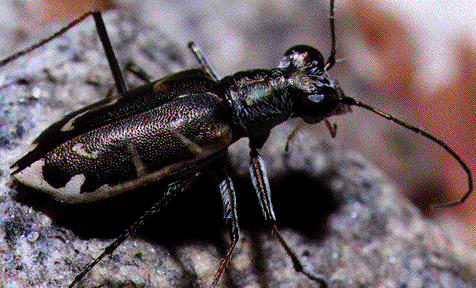Cicindela puritana The Puritan Tiger Beetle |
|---|
 Cicindela puritana (Carabidae:Cicindelinae), The Puritan Tiger Beetle, is a small predatory beach dwelling insect. This species measures 11.5-12.4mm. The elytra are dark bronze with cream markings. The thorax, head, and legs are covered with white hairs In 1990 the Puritan Tiger Beetle was classified as threatened over its entire range under the Federal Endangered Species Act. According to the Connecticut Department of Environmental Protection there are probably fewer than 1,000 individuals left in New England, 99% of which live in CT. Two populations exist on the Connecticut River, one large population in Cromwell-Portland which includes approximately 400-700 adults and a second population in Northampton MA of around 20 adults. A Maryland population of this species exists along the Sassafras, but there numbers have apparently declined from 4,703 in 1990 to 1,098 in 2005. This beetle is threatened by disturbances to its habitat. The extended larval stage is particularly susceptible to flooding and erosion, as they remain sedentary for two years. Hydroelectric dam construction along the Connecticut River has been directly correlated to declines in Cicindela puritana populations. Recreation beach use in known to affect the genus as a whole, as it disrupts mating, oviposition, and hunting behavior of adults. Pollution from mills and other industry are also thought to have negatively impacted this species in particular. In 1993 the federal government created a recovery plan for the Puritan Tiger Beetle. Its goals are to increase the number of large adults populations and create smaller population between to increase genetic variability. Researchers have found that sand quality is of prime importance when predicting female oviposition preference. Larvae from the largest sites have been collected and placed into smaller colonies in accordance with the recovery plan. Habitat protection and restoration are crucial to the recovery of this species. In order to be delisted four criteria must be met. Six populations of C. puritana must be protected along the Chesapeake Bay, along with corridors of smaller populations. Three similar sized populations must be maintained or established along the Connecticut River. Finally, programs must be in place to monitor populations as well as the factors that lead to declining numbers. It is difficult to gauge population growth as numbers vary significantly from year to year. Bluff erosion creates more than just the year to year fluctuation in beetle populations, it also effects human communities existing near the habitats. The bluffs on the Chesapeake Bay regularly slough off due to natural occurrences, which puts human homes at risk. Unfortunately due to its diminutive size and drab coloration this species does not carry the mystique or allure that other threatened invertebrates enjoy, and it has become a target for criticism of the Endangered Species Act and a case for property owner's rights. |
Resources:
|
Orginal Paper : Boutard, 2006 Updated: Eric Denemark, 2008
|
Image credit: Image Credit |